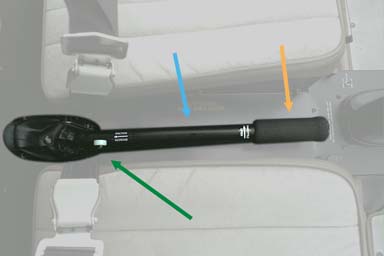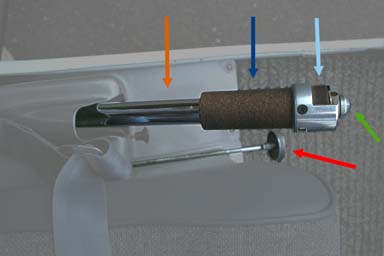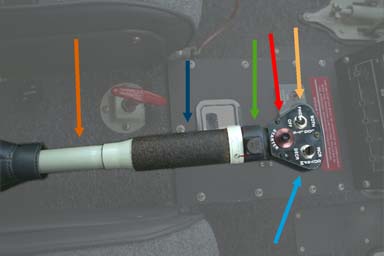
The Robinson R22 offers an optional RPM governor. When this is installed, the pilot will feel the throttle roll on and off as the governor attempts to maintain RPM. Not all R22s have governors, although some of us suspect that an AD (Airworthiness Directive) from the FAA may soon make them mandatory on all R22s. There are two types of governors available on R22s. The old style governor will both roll throttle on and off and move the collective in order to maintain RPM. The new style governor was originally designed for the R44, but is now being installed on R22s as well. This governor uses throttle, but not collective, to maintain RPM. It is extremely effective.

The blue arrow points to the collective lever (which the throttle twist grip is mounted on). The collective lever is connected to the swash plate by a series of push-pull tubes. Raising the collective lever increases the pitch on the main rotor blades, lowering the collective lever decreases the main rotor blade pitch.
The green arrow on the left points to the collective friction control. This control allows the pilot to control the amount of force it takes to move the collective control. The friction can be used on the ground and in flight in the Robinson helicopters.

The orange arrow points to the collective lever, which works identically to the collective lever on the Robinson.
The red arrow points to the collective friction knob. Unlike the Robinson, Enstrom does not allow you to use collective friction in flight. The control is provided because during startup and shutdown the collective has a tendance to raise to the up position all on it's own. The friction is used to hold the collective down during these times.
The green arrow points to the starter button, which is on the end of the collective. This allows the pilot to activate the engine starter motor without having to take his hand off the collective. If the engine stalls during flight, he can enter autorotation while simultaneously cranking the engine to attempt to restart it. Contrast that with the Robinson which requires you to take your hand off the collective to crank with the key switch. The Enstrom only provides the starter on the left hand collective.

The dark blue arrow points to the throttle twist grip. This performs the function of an engine condition control, with positions for off, idle, and flight. In the flight position the throttle is rolled full open, and the fuel control (governor) controls the amount of fuel going to the engine in order to maintain proper rotor RPM. Between the flight and idle positions, the throttle can be used as a manual throttle, although this would only be done during an emergency (or simulated emergency) condition. This is useful during any event which would cause engine or rotor RPM to go too high, such as a high side governor failure or short shaft failure. The throttle can be rolled off to limit the amount of fuel going to the engine so that RPM is maintained in the green operating arc. Another time when this is useful is while landing after a tail rotor failure. The throttle can be manipulated to produce the amount of torque required to line the landing gear up with ground track during a running landing. The throttle can not be used to increase fuel flow over what the governor is commanding, which means it can not be used as a manual fuel control to correct for a low side governor failure.
The green arrow is pointing to the idle release button. When the throttle is rolled from "off" to "idle", the idle release button snaps into a detent which prevents the throttle from being rolled back to "off". This prevents the pilot from flaming out the engine when going from "flight" to "idle". In order to move the throttle from "idle" to "off", the pilot must hold down the idle release button while rolling the throttle to "off".
The red arrow is pointing at the starter button. Pushing this button causes the starter/generator to act as a starter motor, turning over the engine. The starter can also be used to motor the engine in order to cool it down by forcing cool air through it.
The yellow arrow points at the landing light switch, which is a three position switch. The three positions are "off", "forward" and "both". In forward, only the forward pointing light is activated. In "both", the forward and the downward angled lights are activated.
The blue arrow on the bottom points to the governor trim switch. By holding it in "increase" or "decrease" the pilot can set the RPM that the governor will attempt to maintain.